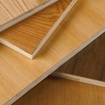2012 Soy-Based Wood Adhesives Technical Data Review
BACKGROUND
Soy-based adhesives have been used to manufacture common wood products such as plywood for over 70 years. While soy adhesives are still used in some specific applications, the introduction of urea-formaldehyde and phenol-formaldehyde resins in the late 1930s provided greater water resistance and lower costs than the older soy products.
Environmental concerns and rising costs for petrochemical-based resins and requests from users for adhesives made from a renewable feedstock have caused a resurgence of interest in developing new soy-based products for the wood adhesives industry. One of the primary successes of United Soybean Board-funded research is the use of soy in formaldehyde-free glues for use in interior hardwood plywood.
TECHNOLOGY
Soy-based technology for use in composite wood panels centers around several different technologies, all developed to produce lower-cost or more environmentally friendly systems.
The first system was developed for plywood, oriented strand board and engineered wood products. Low-cost soy meal/soy flour can be substituted for up to 25 percent of the more
expensive phenol component. The soy flour is first converted to a soy hydrolysate, which is then co-reacted with a phenolic resin. The resulting soy phenol-formaldehyde resin exhibits properties comparable to a phenol-formaldehyde resin.
The second system involved the use of soy flour in foamed glue-extruded systems for laminating plywood veneers. In this system, soy flour is substituted for animal blood, which was used as a foaming agent for phenol-formaldehyde resins.
The main benefit for foamed glues over other application systems was the savings in resin usage. Other benefits were reduced glue spread, reduced glue waste and minimal cleanup time. The soy flour was introduced to replace animal blood as a foaming agent because it is cost-competitive, avoids odors and is safer to use and handle.
The most current technology involves the use of soy meal/soy flour in formaldehyde-free adhesives developed to minimize the amount of formaldehyde emitted from the
resin in wood composite boards.
Recently, the International Agency for Cancer Research classified formaldehyde as a
known carcinogen, causing many composite wood panel manufactures to look for alternatives to the urea-based formulations with which formaldehyde is released into the
environment, particularly in hot and humid conditions.
ADHESIVE PRODUCTS
In 2005, Columbia Forest Products announced the first use of formaldehyde-free glue systems when it converted from urea-formaldehyde adhesives to a patented soy system
cooperatively developed by Columbia, the College of Forestry at Oregon State University and Hercules International.
Hercules was granted a worldwide license to use this technology in the wood composite panel market. Columbia was awarded a lifetime license to utilize this patented adhesive system for all of its North American panel business, which included interior hardwood plywood. PureBond® is the trademark Columbia uses for formaldehyde-free plywood panels utilizing this soy adhesive technology.
Hercules, purchased by Ashland in 2008, continued in conjunction with Heartland Resource Technologies to develop a completely formulated soy adhesive, SOYAD®, for use in wood composites, including particleboard and medium-density fiberboard. These
soy adhesives systems are easy to prepare in the panel mills and do not require harsh reaction conditions.
(NOTE: SOYAD® adhesive technology is now manufactured and marketed by Solenis.)


